L14 Reproductive Behavior
Introduction - Boxing in animals
Boxing is a captivating prelude to the mating season in some hares and rabbits
- Induced ovulators(诱导排卵) : Rabbits and hares are classed as induced ovulators(certain cats, shrews, and camelids)
- Spontaneous ovulators(自发排卵): Most mammals—indeed most animals of all kinds—are classed as spontaneous ovulators because ovulation results from processes endogenous to the female, more or less independent of mating(Humans, most rodents, dogs, and farm animals such as cows and sheep)
What aspects of reproduction do physiologists study?
- Mechanisms of mate association
- Control of the annual cycle of reproduction
- Mechanism of function of the reproductive cells and organs
- Coordination of the reproductive organs by neural, endocrine and neuroendocrine mechanisms
- Deliver of resources to offspring by parents
- Physiology of the young
一、Female reproduction
The physiology of induced ovulation in female rabbits
Sexual reproduction
Asexual production : like coral reef, through bidding
In natural environment, wild rabbits exhibit a strong seasonal cycle of reproductive competence.
- Male rabbits their testes regress in winter to only 1/3 of their summer size
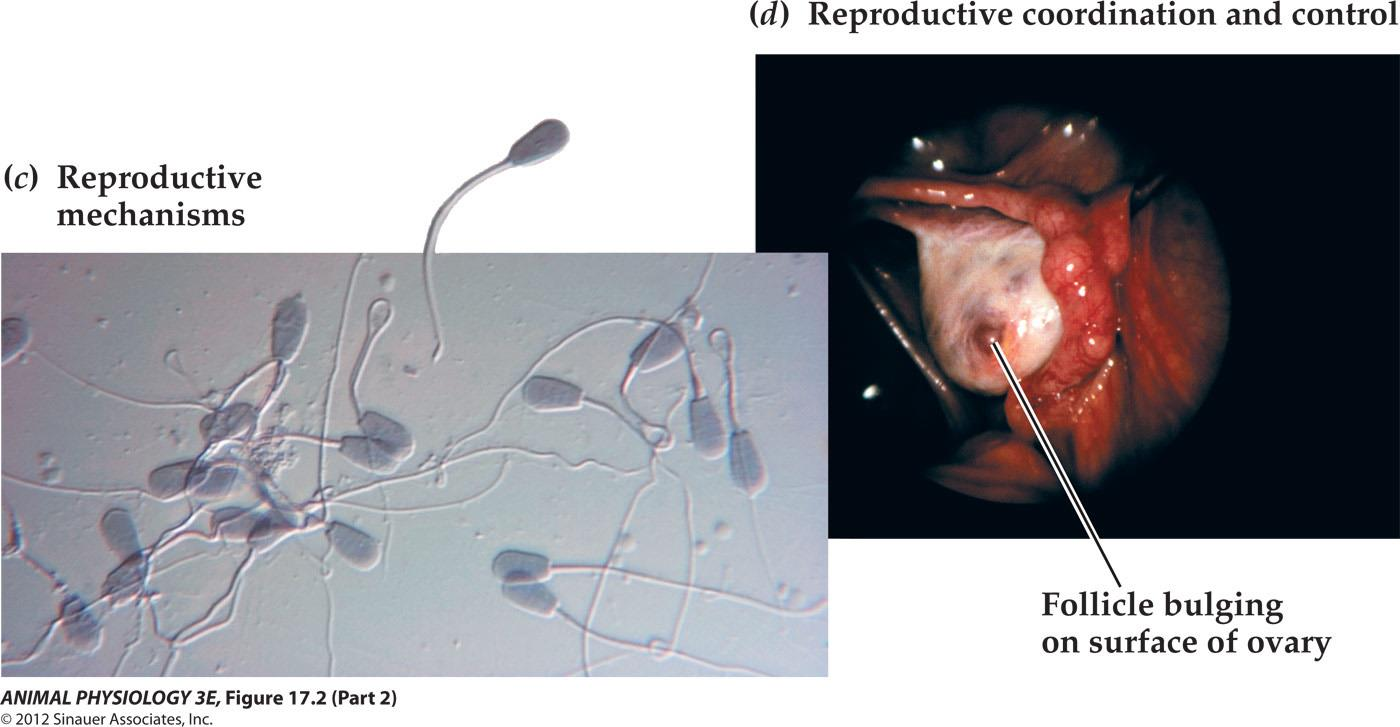
The physiology of induced ovulation in female rabbits
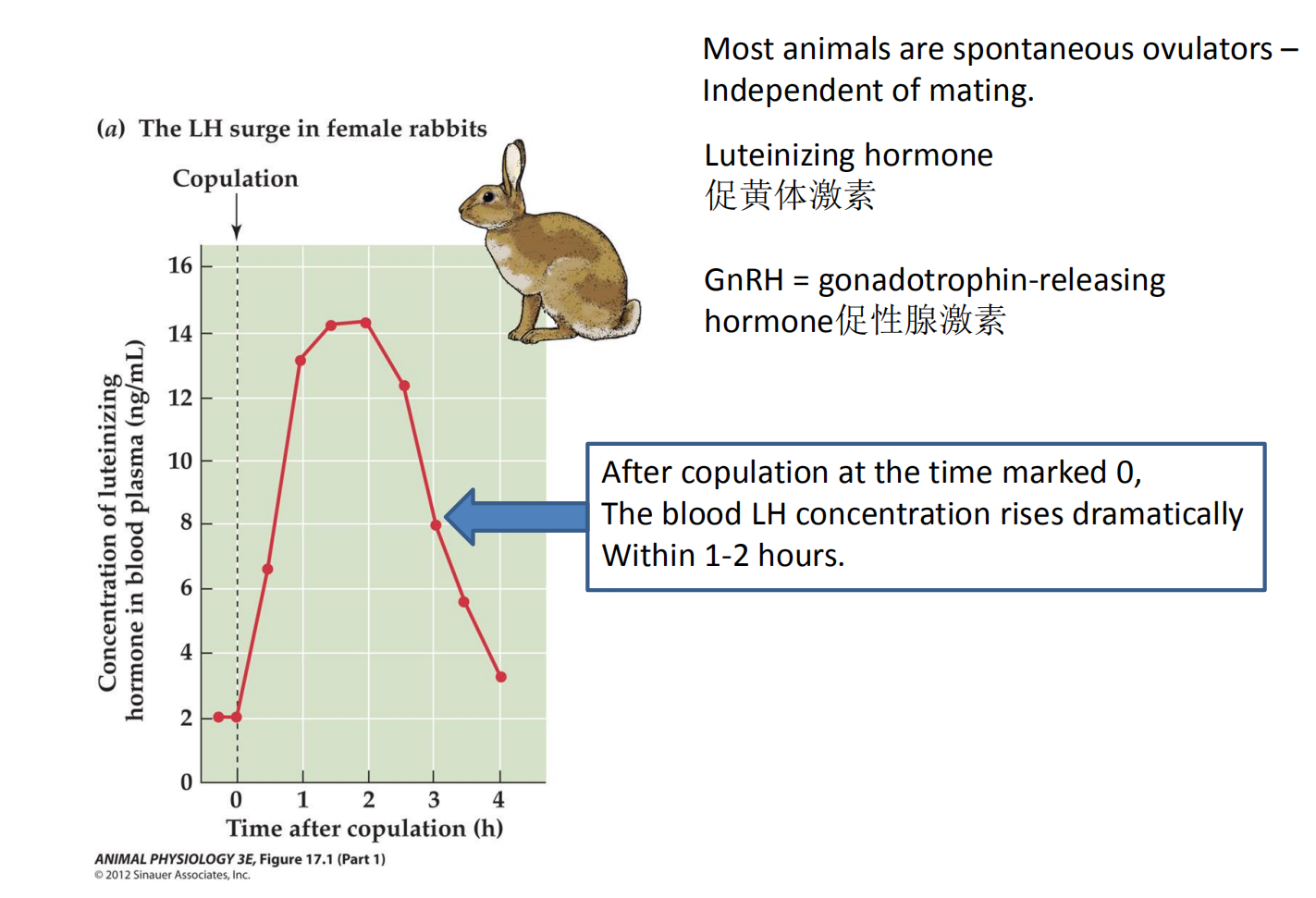
- Most animals are spontaneous ovulators – Independent of mating.
- Luteinizing hormone 促黄体激素
- GnRH = gonadotrophin-releasing hormone 促性腺激素
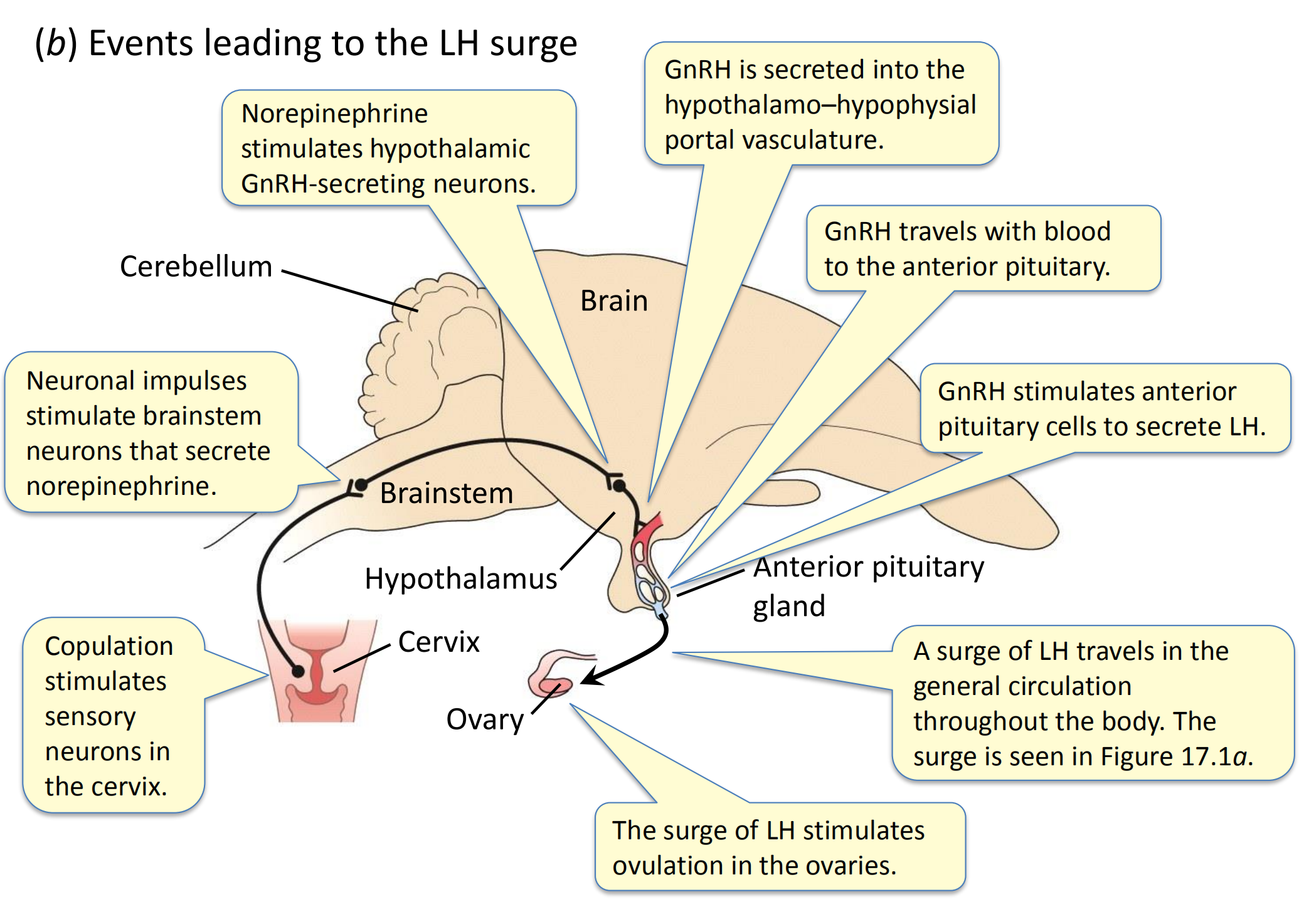
- Copulation stimulates sensory neurons in the cervix(宫颈).
- Neuronal impulses stimulate brainstem neurons that secrete norepinephrine.
- Norepinephrine stimulates hypothalamic GnRH-secreting neurons.
- GnRH is secreted into the hypothalamo–hypophysial portal vasculature
- GnRH travels with blood to the anterior pituitary.
- GnRH stimulates anterior pituitary cells to secrete LH.
- A surge of LH travels in the general circulation throughout the body. The surge is seen in Figure 17.1a.
- The surge of LH stimulates ovulation in the ovaries.
The human female reproductive system
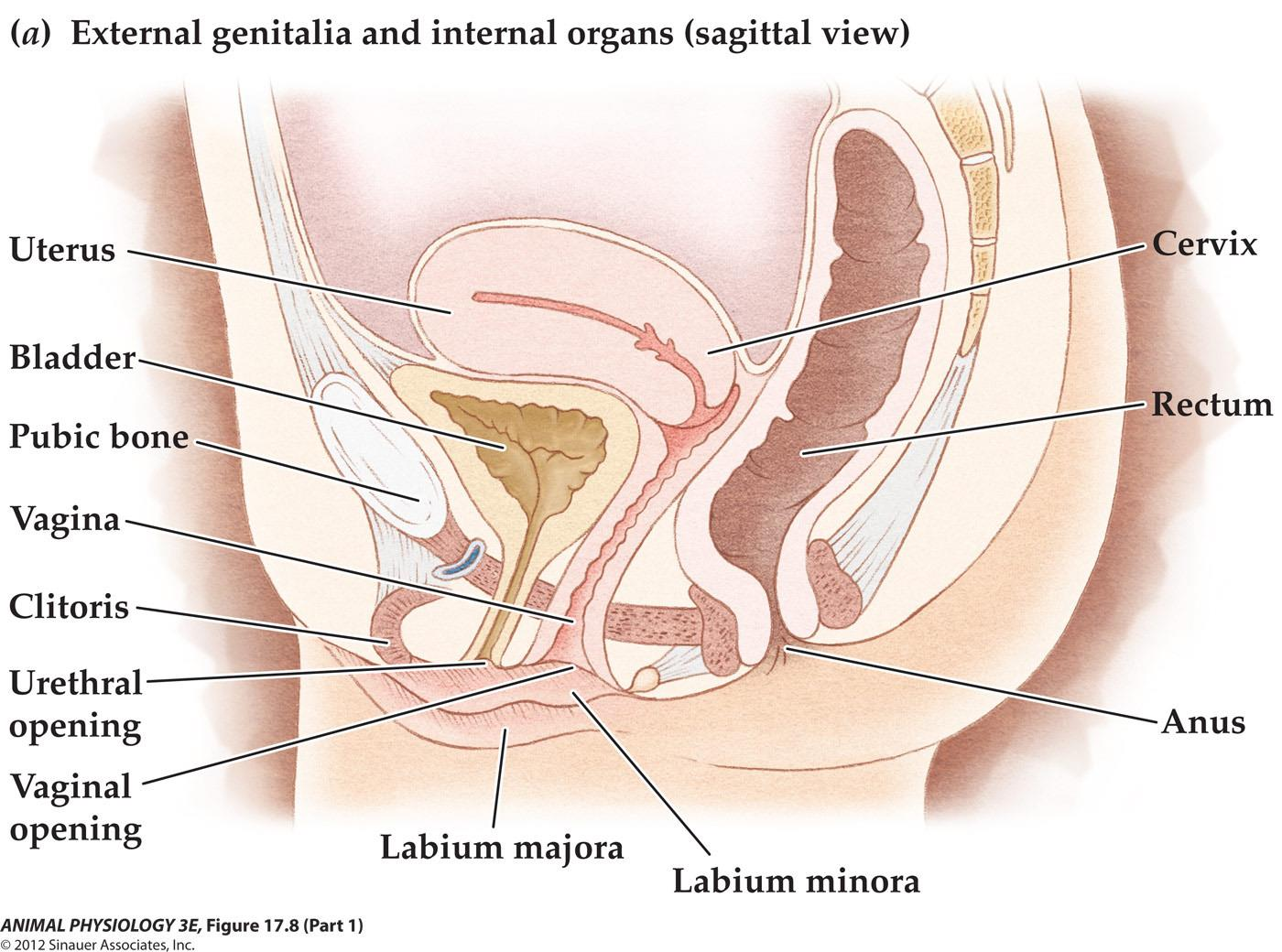
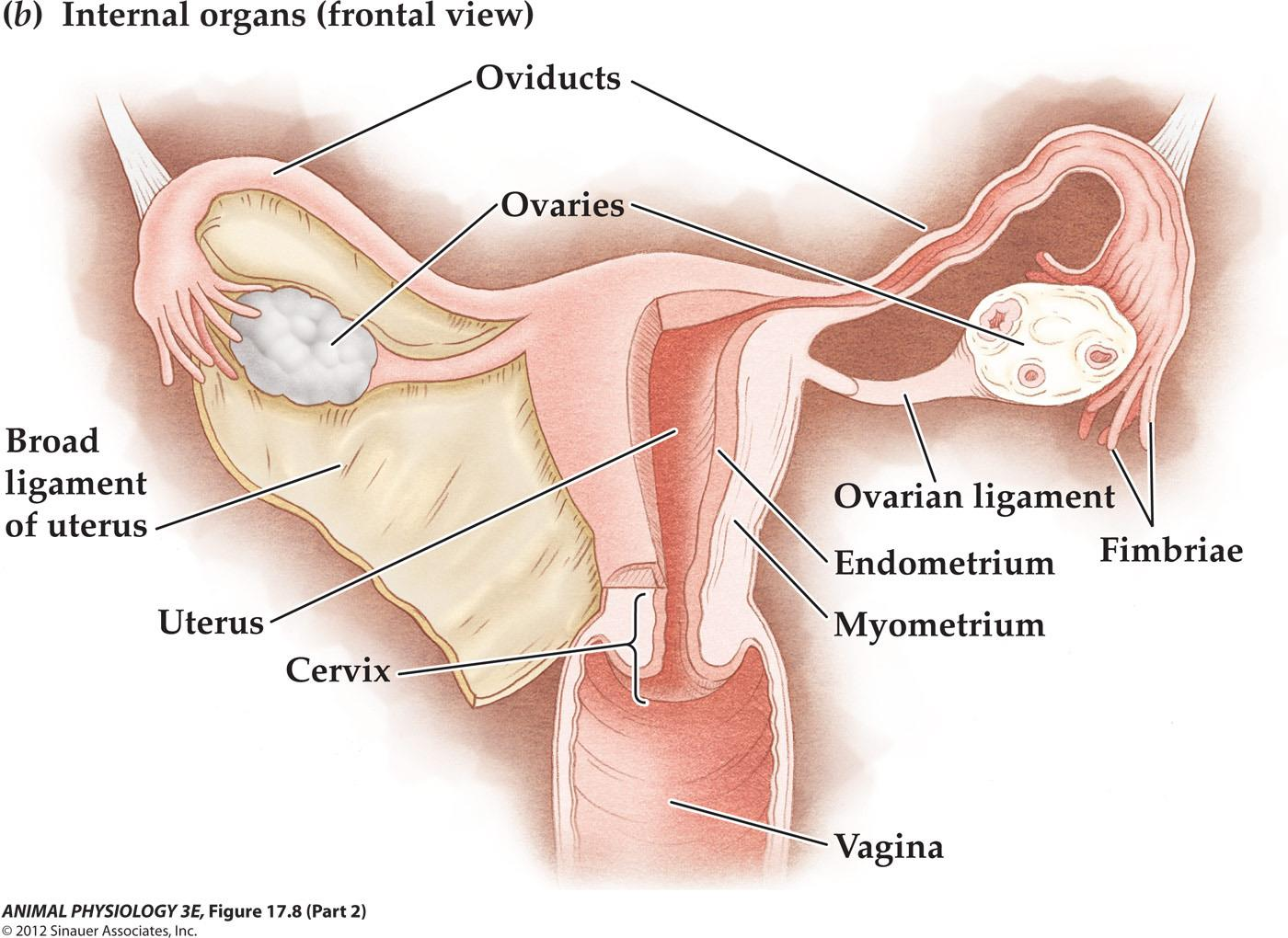
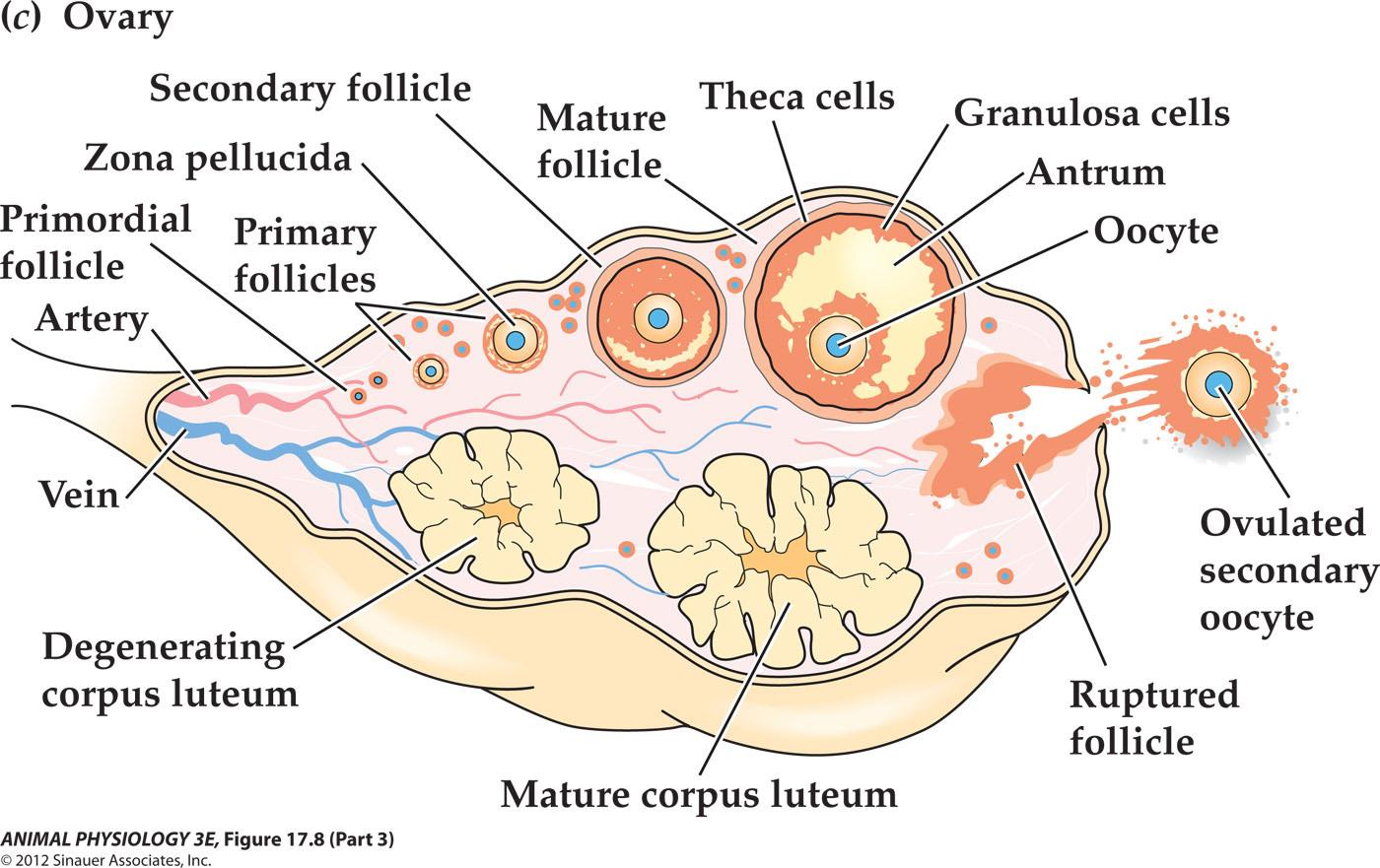
Folliculogenesis:
- Primordial follicle: an oocyte and its layer of somatic cells.
- Primary follicle: granulosa cells and the oocyte (somatic cells become granulosa cells). Oocyte secretes a noncellular layer of glycoprotein – zona pellucida(透明带)
- Secondary follicle: a fluid-filled cavity, the antrum(窦腔), opens up within the layers of granulosa cells.
- Theca cells(卵泡膜细胞): a layer of connective tissue outside of the granulosa cells.
1. Hormonal control of estrogen production and secretion by an ovarian follicle
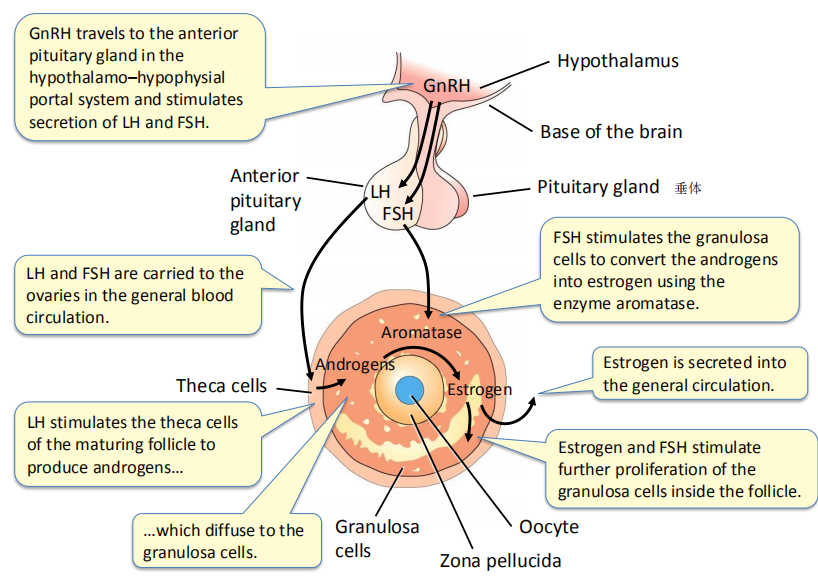
- GnRH travels to the anterior pituitary gland(垂体前叶) in the hypothalamo–hypophysial portal system and stimulates secretion of LH and FSH.
- LH and FSH are carried to the ovaries in the general blood circulation
- FSH stimulates the granulosa cells(颗粒细胞) to convert the androgens into estrogen using the enzyme aromatase
- LH stimulates the theca cells(卵泡膜细胞) of the maturing follicle to produce androgens, which diffuse to the granulosa cells
- Estrogen and FSH stimulate further proliferation of the granulosa cells inside the follicle
2. A synoptic view of events in the human female reproductive cycle
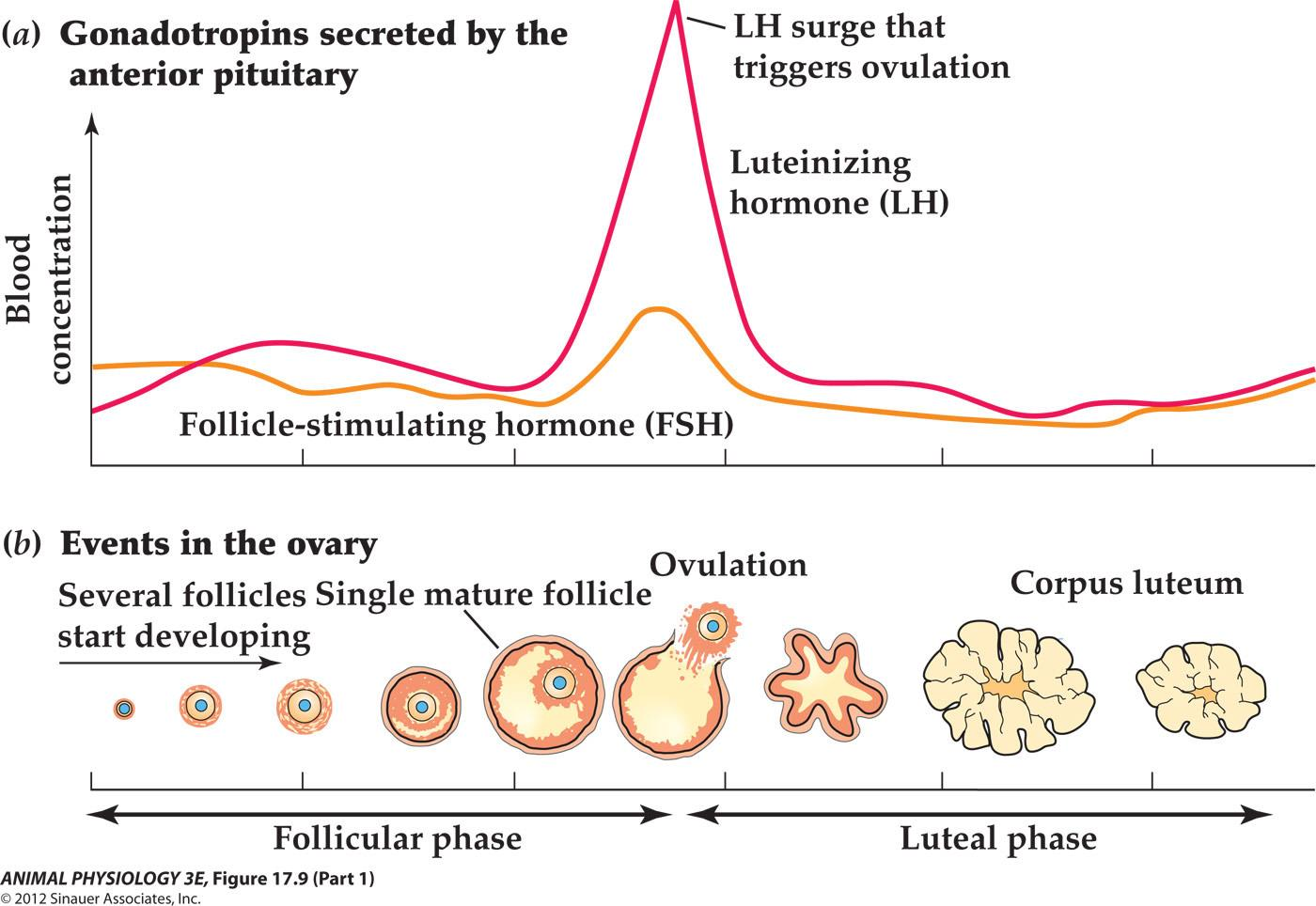
- GnRH secretion can be affected by Mulnutrition and stress
3. Endocrine control of the luteal phase(黄体期)
The corpus(黄体) luteal is essential for establishing the conditions that permit implantation and pregnancy

- The corpus luteal secretes progesterone(黄体酮), estrogen(雌激素) and inhibin(抑制素)
- Progesterone, estrogen act in concert to exert negative feedback on the anterior pituitary to keep GnRH, LH and FSH secretion low.
- Inhibin also suppresses FSH secretion
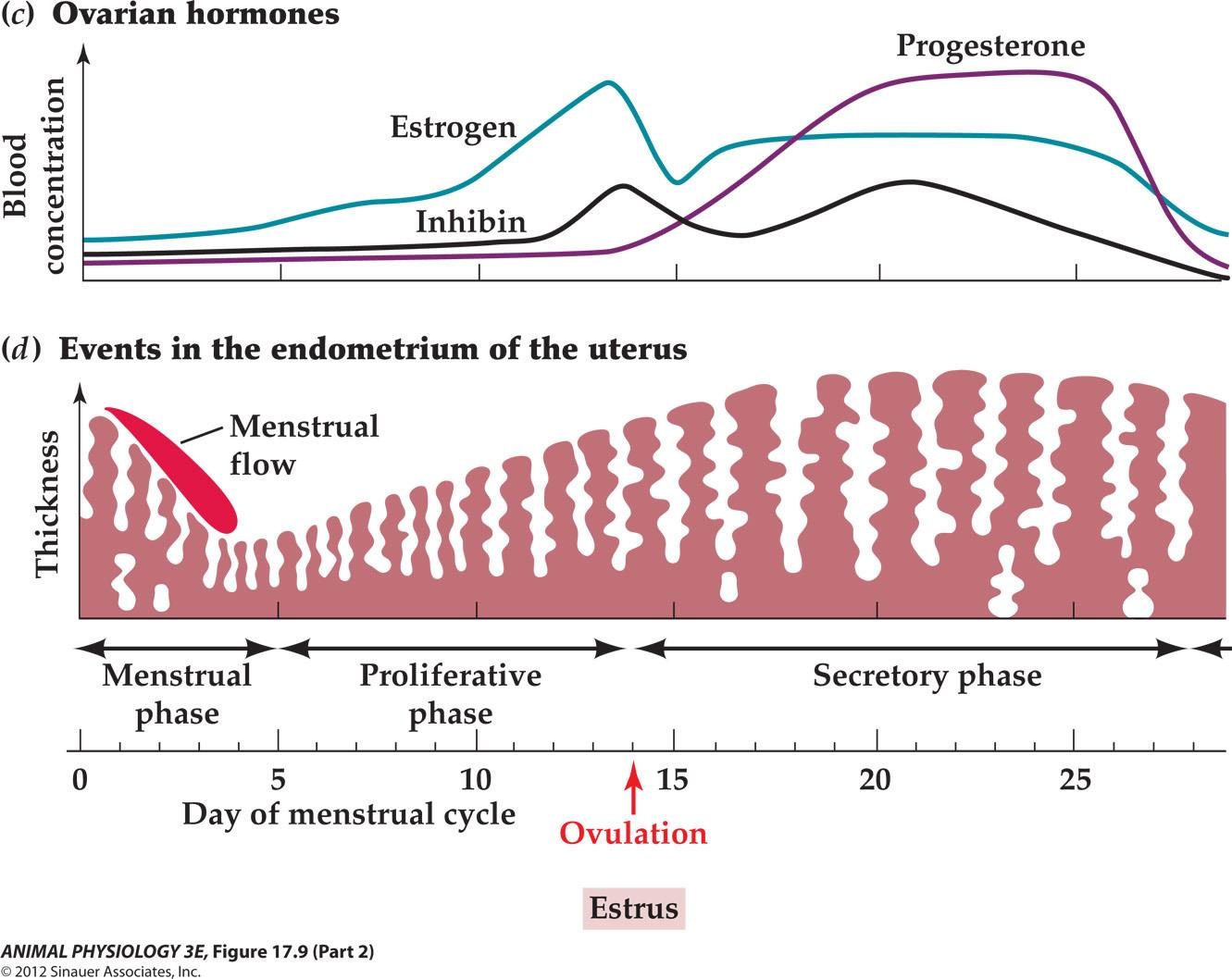
- Menstrual phase 月经期
- Proliferative phase 增殖期
- Secretory phase
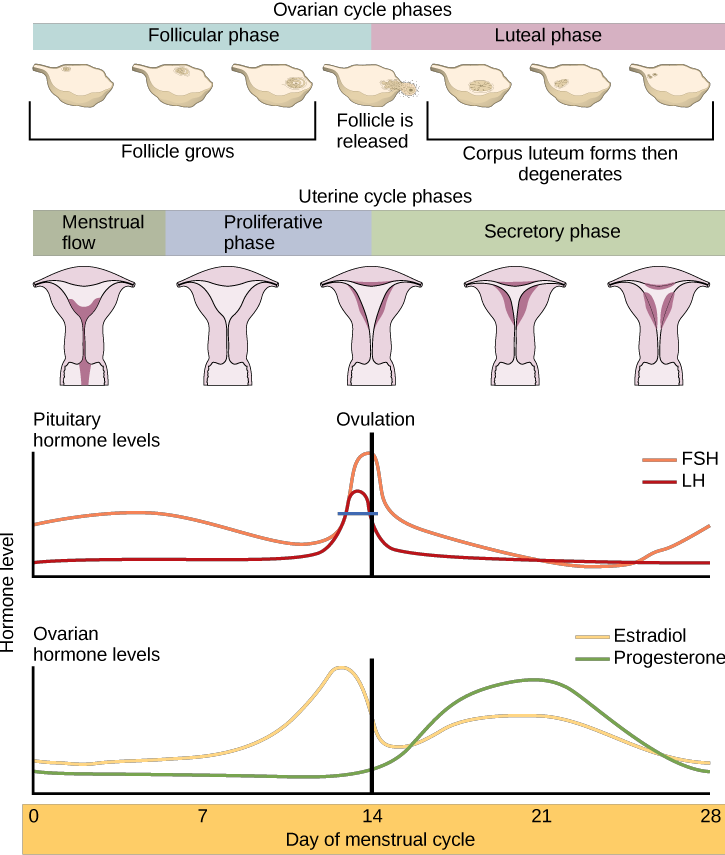
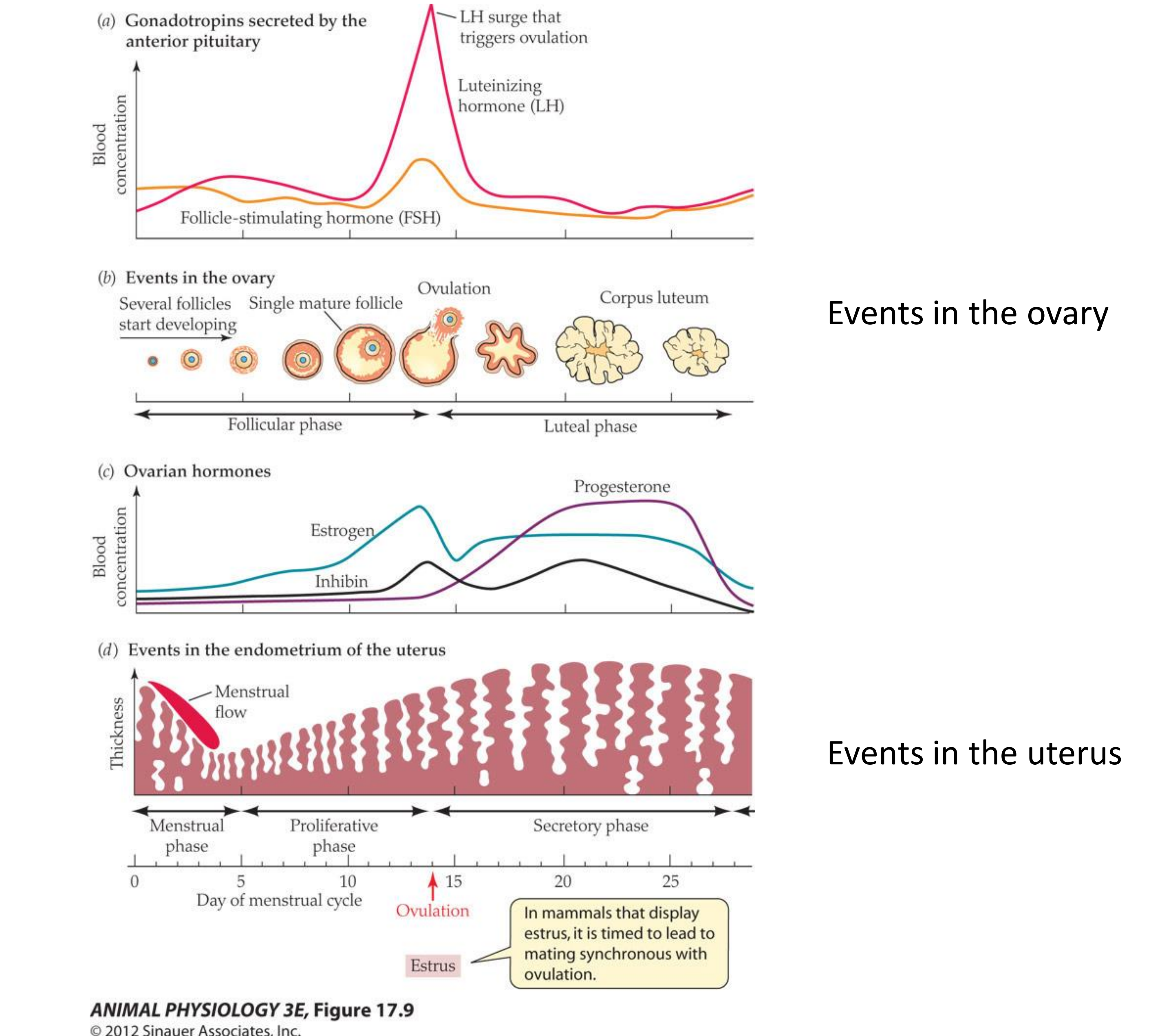
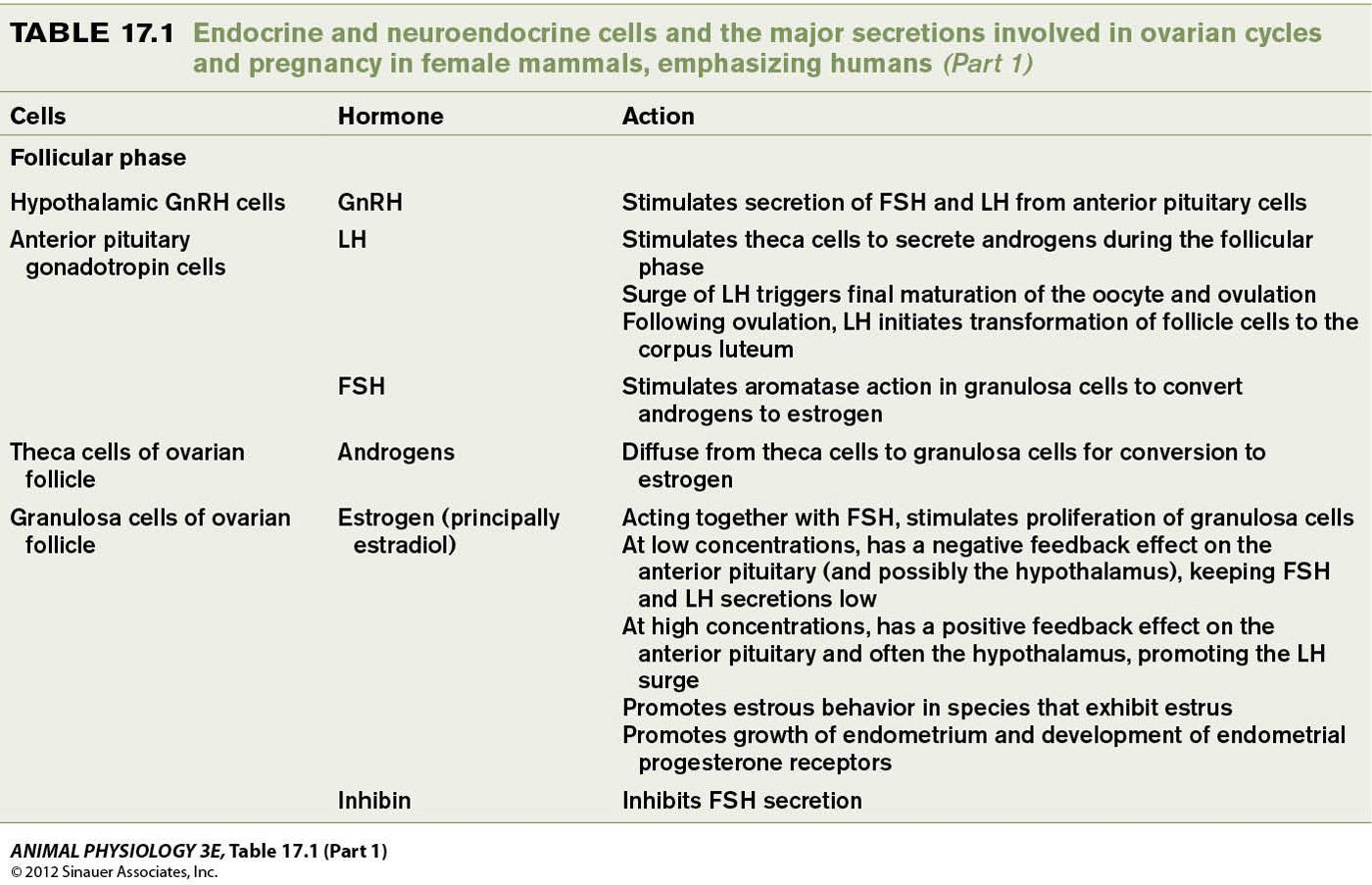
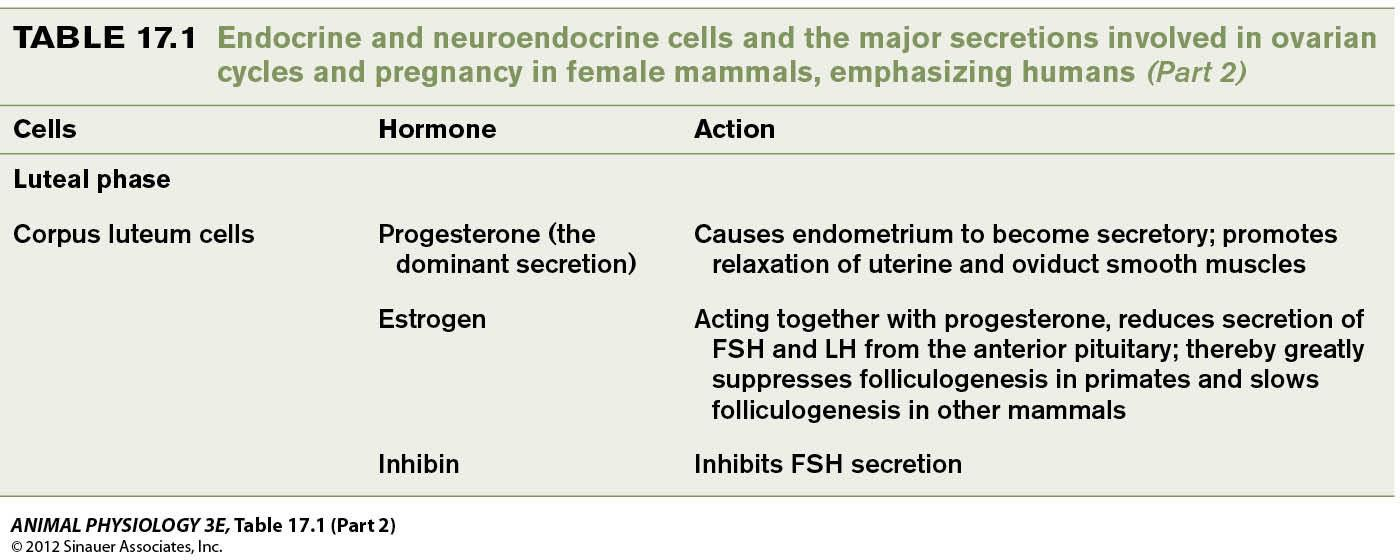
| Cells | Hormone | Action |
|---|---|---|
| Follicular Phase | ||
| Hypothalamic GnRH cells | GnRH 促性腺激素释放激素 | Stimulates secretion of FSH and LH from anterior pituitary cells |
| Anterior pituitary, gonadotropin cells | LH 促黄体生成激素 | 1. Stimulates theca cells to secrete androgens during the follicular phase 2. Surge of LH triggers final maturation of the oocyte and ovulation 3. Following ovulation, LH initiates transformation of follicle cells to the corpus luteum |
| FSH 卵泡刺激素 | Stimulates aromatase action in granulosa cells to convert androgens to estrogen | |
| Theca cells of ovarian follicle | Androgens | Diffuse from theca cells to granulosa cells for conversion to estrogen |
| Granulosa cells of ovarian follicle | Estrogen (principally estradiol) | 1. Acting together with FSH, stimulates proliferation of granulosa cells 2. At low concentrations, has a negative feedback effect on the anterior pituitary (and possibly the hypothalamus), keeping FSH and LH secretions low 3. At high concentrations, has a positive feedback effect on the anterior pituitary and often the hypothalamus, promoting the LH surge 4. Promotes estrous behavior in species that exhibit estrus 5. Promotes growth of endometrium and development of endometrial progesterone receptors |
| Inhibin | Inhibit FSH secretion | |
| Luteal phase | ||
| Corpus luteum cells | Progesterone (the dominant secretion) | Causes endometrium to become secretory; promotes relaxation of uterine and oviduct smooth muscles |
| Estrogen | Acting together with progesterone, reduces secretion of FSH and LH from the anterior pituitary; thereby greatly suppresses folliculogenesis in primates and slows folliculogenesis in other mammals | |
| Inhibin | Inhibits FSH secretion |
The cells of corpus luteum have a limited life span in the absence of pregnancy
- if no pregnancy occurs, luteal cells stop secreting hormones and degenerate., which sets the stage for a new cycle of folliculogenesis.
- Endometrium, no longer supported by luteal hormones, is sloughed off
- Endometrium secreting prostaglandins (前列腺素), which causes the constriction of the uterine blood vessels and contraction of the myometrium. Lack of oxygen , cells begin to die.
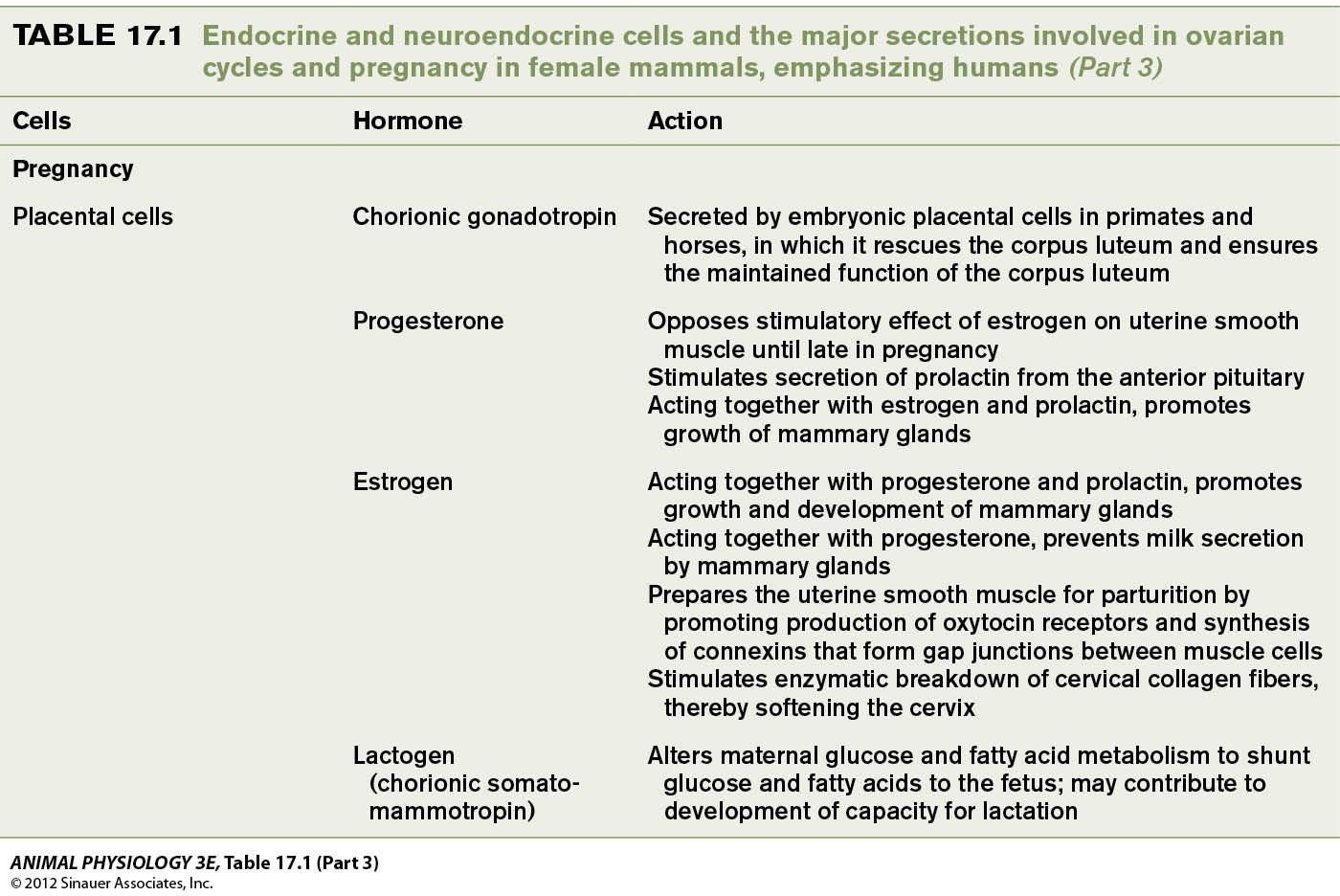
| Cells | Hormone | Action |
|---|---|---|
| Pregnancy | ||
| Placental Cells | Chorionic gonadotropin 绒毛膜促性腺激素 | Secreted by embryonic placental cells in primates and horses, in which it rescues the corpus luteum and ensures the maintained function of the corpus luteum |
| Progesterone 孕酮 | 1. Opposes stimulatory effect of estrogen on uterine smooth muscle until late in pregnancy 2. Stimulates secretion of prolactin from the anterior pituitary 3. Acting together with estrogen and prolactin, promotes growth of mammary glands |
|
| Estrogen | 1. Acting together with progesterone and prolactin, promotes growth and development of mammary glands 2. Acting together with progesterone, prevents milk secretion by mammary glands 3. Prepares the uterine smooth muscle for parturition by promoting production of oxytocin receptors and synthesis of connexins that form gap junctions between muscle cells 4. Stimulates enzymatic breakdown of cervical collagen fibers thereby softening the cervix |
|
| Lactogen (chorionic somatomammotroph) | Alters maternal glucose and fatty acld metabolism to shunt glucose and fatty acids to the fetus; may contribute to development of capacity for lactations |
二、Male reproduction
The human male reproductive system

The prostate gland and the paired Seminal vesicles secrete most of The fluid released during ejaculation
- Semen contains this fluid and sperm cells
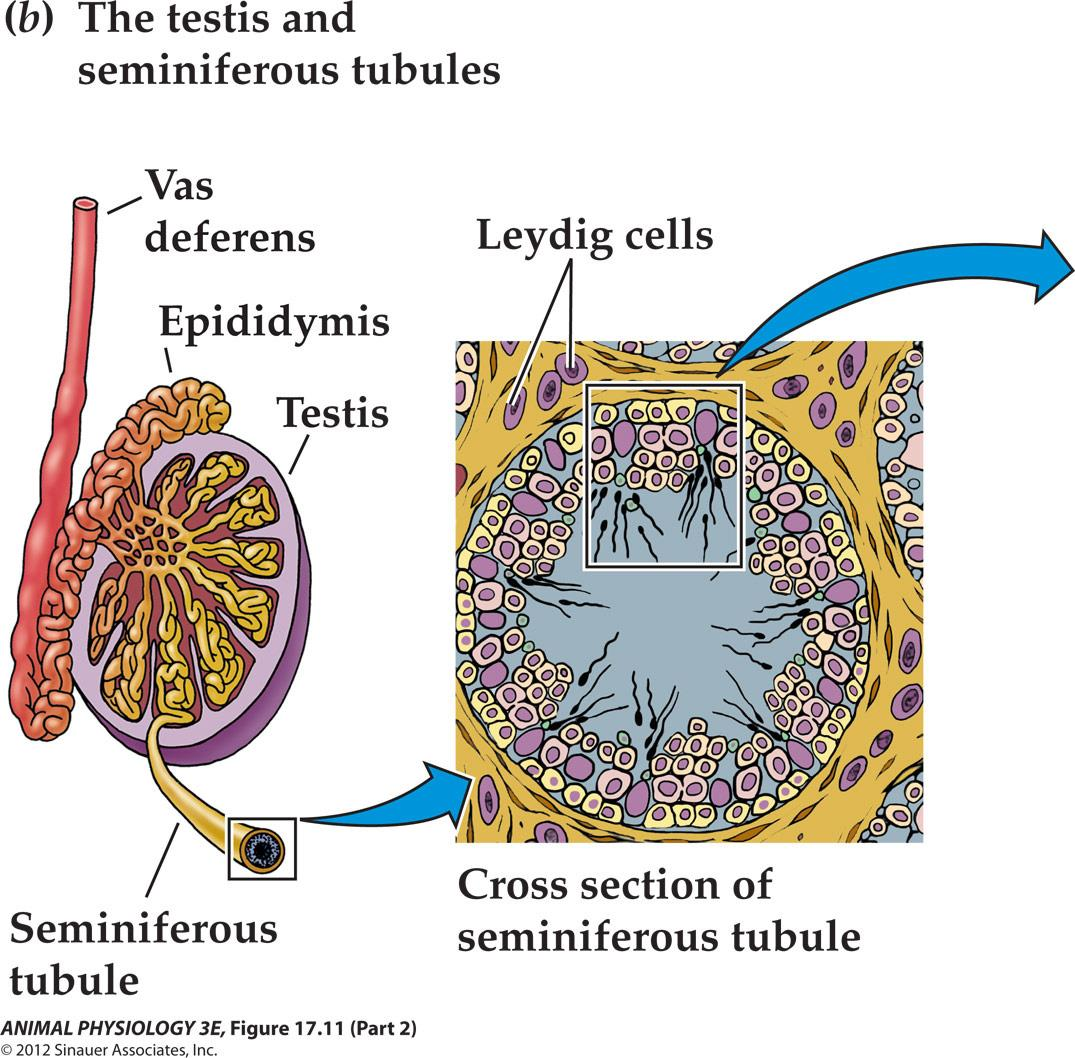
Leydig cells(睾丸间质细胞) secret testosterone(睾酮)
Mature sperms are stored in the epididymis and vas deference.
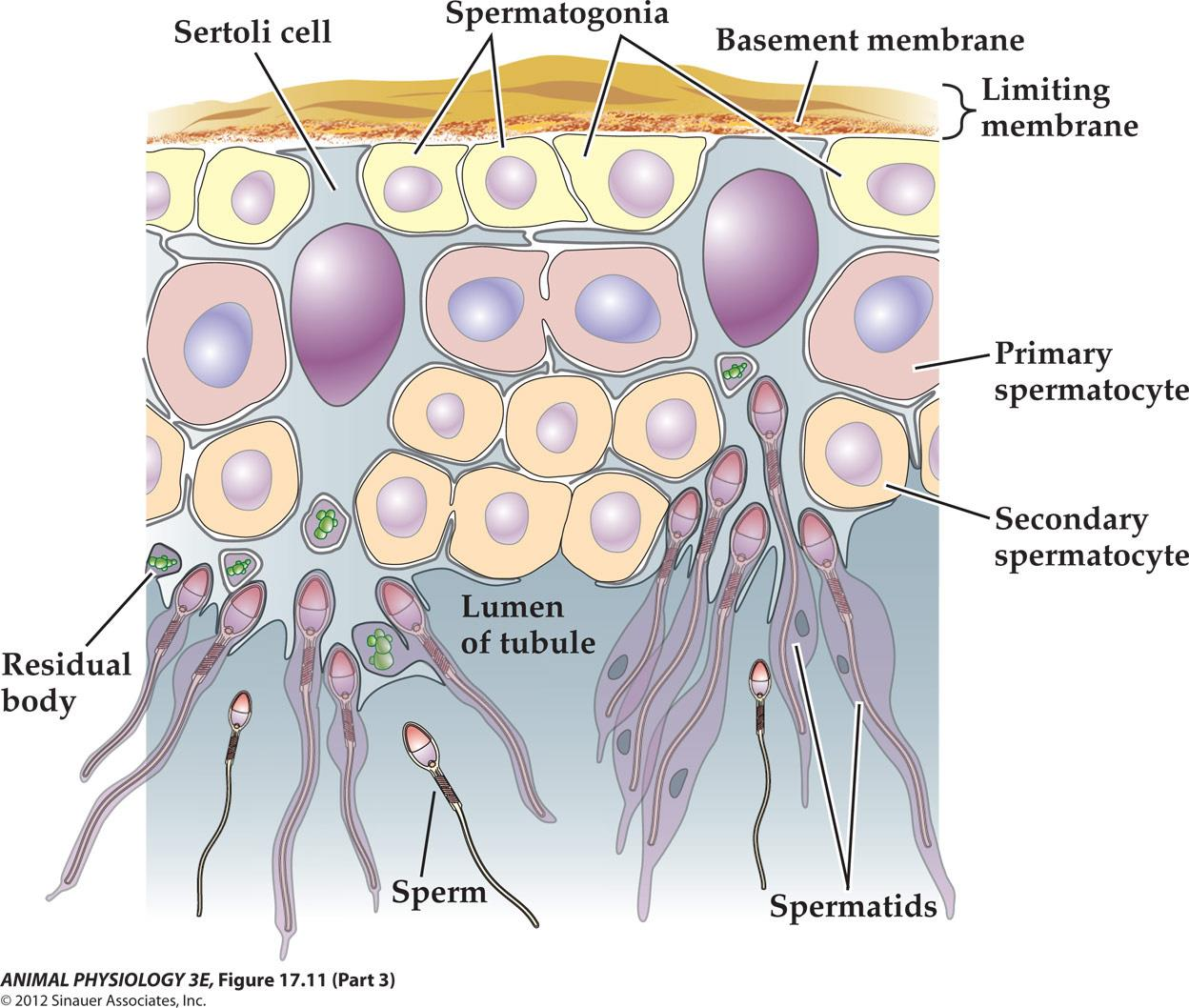

Testosterone secretion and sperm production during the life span of human males
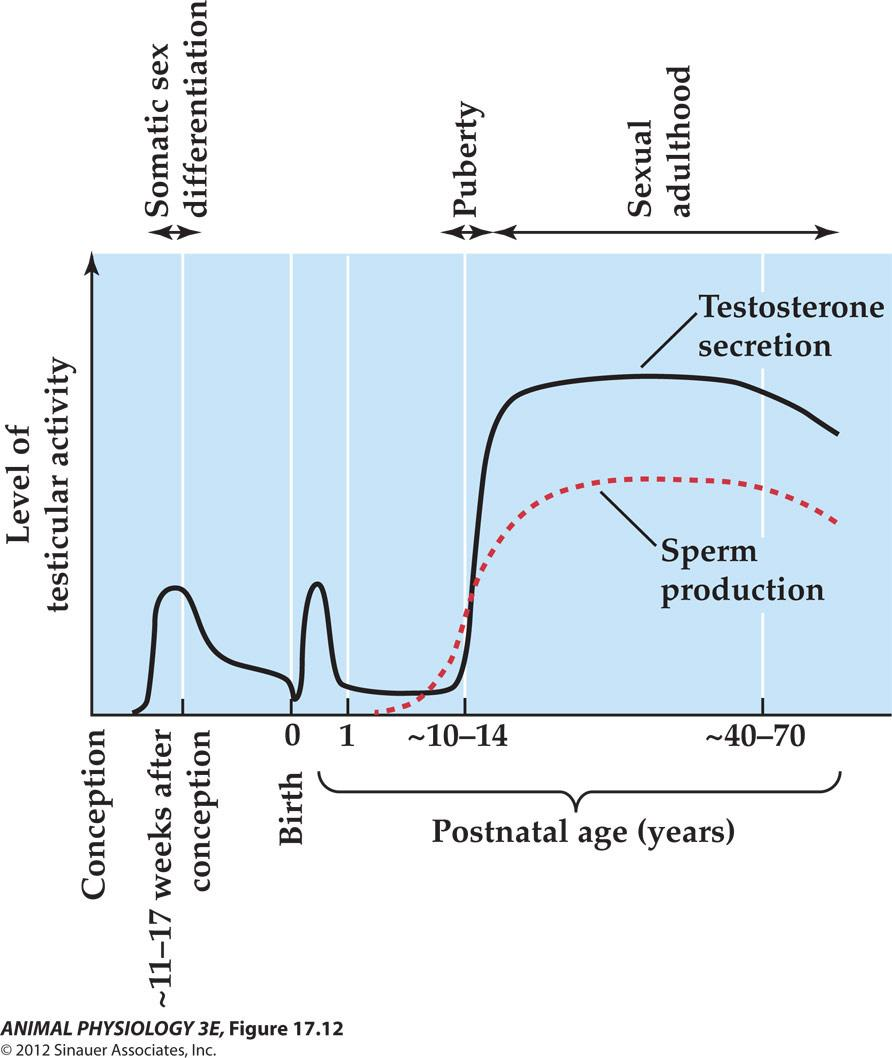
- Males produce sperm continually during the reproductive season
The brain and pituitary hormones involved are the same as those in females
- GnRH is released from the hypothalamus and LH and FSH are secreted from the anterior pituitary gland.
- LH targets Leydig cells to produce testosterone
- FSH targets Sertoli cells to stimulate spermatogenesis.
- Both LH and FSH are relatively stable in male to sustain the constant production sperm.
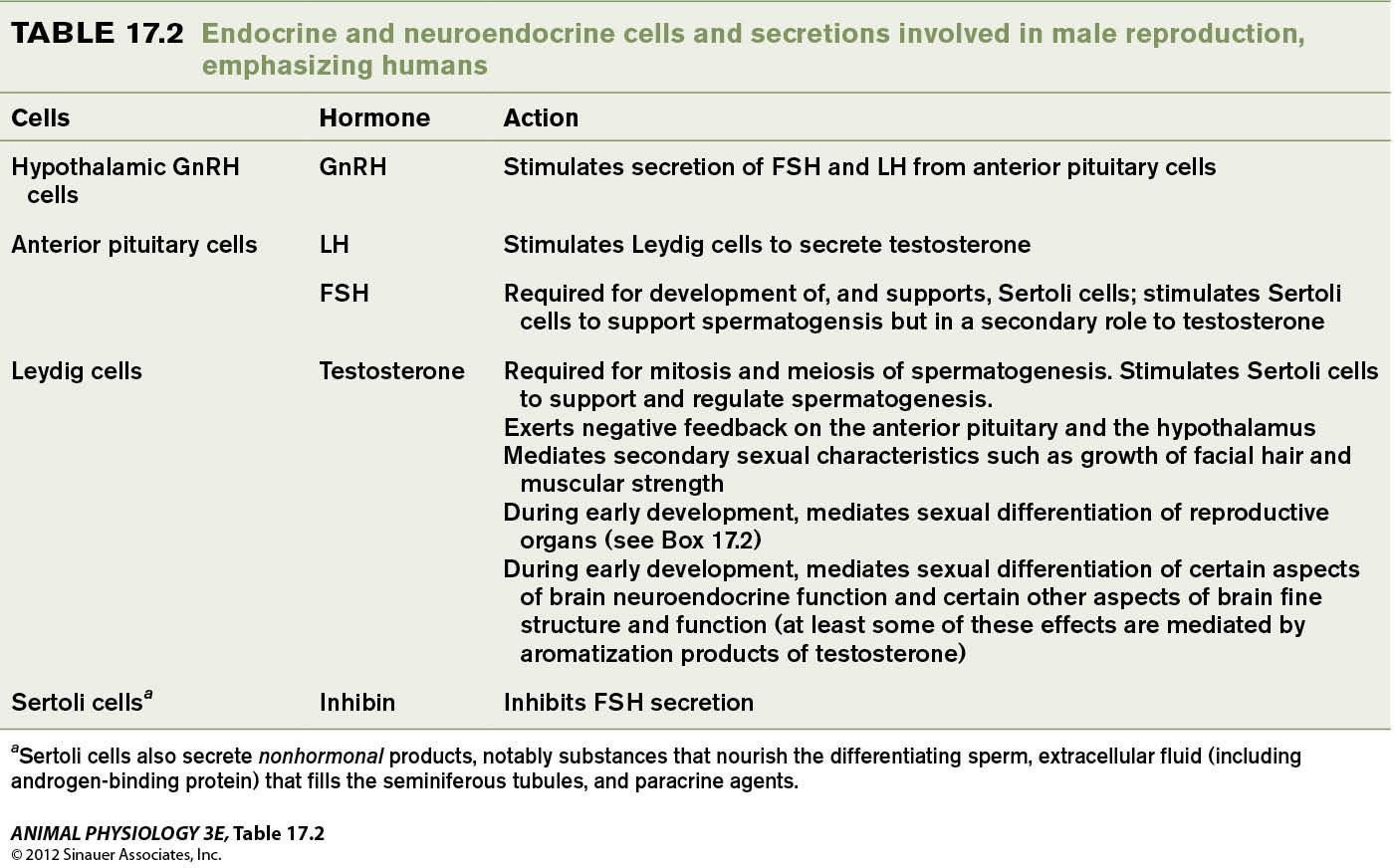
| Cells | Hormone | Action |
|---|---|---|
| Hypothalamic GnRH cells | GnRH | Stimulates secretion of FSH and LH from anterior pituitary cells |
| Anterior pituitary cells | LH | Stimulates Leydig cells to secrete testosterone |
| FSH | Required for development of, and supports, Sertoli cells; stimulates Sertoli cells to support spermatogensis but in a secondary role to testosterone | |
| Leydig cells (睾丸间质细胞) | Testosterone | 1. Required for mitosis and meiosis of spermatogenesis. Stimulates Sertoli cells to support and regulate spermatogenesis 2. Exerts negative feedback on the anterior pituitary and the hypothalamus 3. Mediates secondary sexual characteristics such as growth of facial hair and muscular strength 4. During early development, mediates sexual differentiation of reproductive organs(see Box 17.2) 5. During early development, mediates sexual differentiation of certain aspects of brain neuroendocrine function and certain other aspects of brain fine structure and function (at least some of these effects are mediated by aromatization products of testosterone) |
| Sertoli cells (睾丸支持细胞) | Inhibin | Inhibits FSH secretion |
Erection and Ejaculation
Nitric oxide (NO)–Nobel prize in medicine and physiology for 1998
Bats and carnivore, their penises contain a bone
Nitric oxide (NO), a messenger molecule, is the immediate mediator of erection. Released from the parasympathetic nerve endings in the penis
- NO leads to dilation of blood vessels that permits blood to fill the spongy tissues.
三、Fertilization
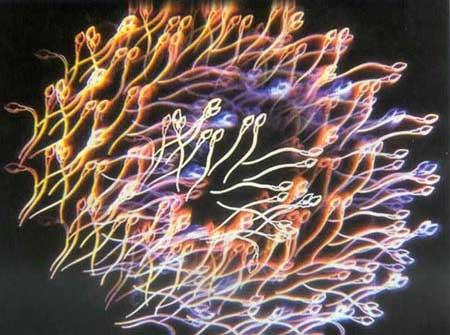
- External fertilization (aquatic animals)
- Internal fertilization (fertilization occurs in the female reproductive track).
Only one sperm will be able to reach and fertilize the egg

- A cloud of granulosa cells(颗粒细胞) surrounds the oocyte
- Enzymes on the cell membrane of the sperm digest a path through the surrounding granulosa cells.
- The sperm head binds to species specific receptor molecules on the zona pellucida(透明带)
- undergoes the acrosomal reaction, which releases enzymes to allow the sperm to cut a path through the zona pellucida and cross the perivitelline space(卵黄周间隙)
- The sperm head then binds to the oocyte cell membrane,
- The perivitelline space is an extracellular space between the oocyte and zona pellucida
- Sperm head fuses with oocyte membrane, and releases its contents into the cytoplasm of the oocyte.
Zygote to Blastocyst
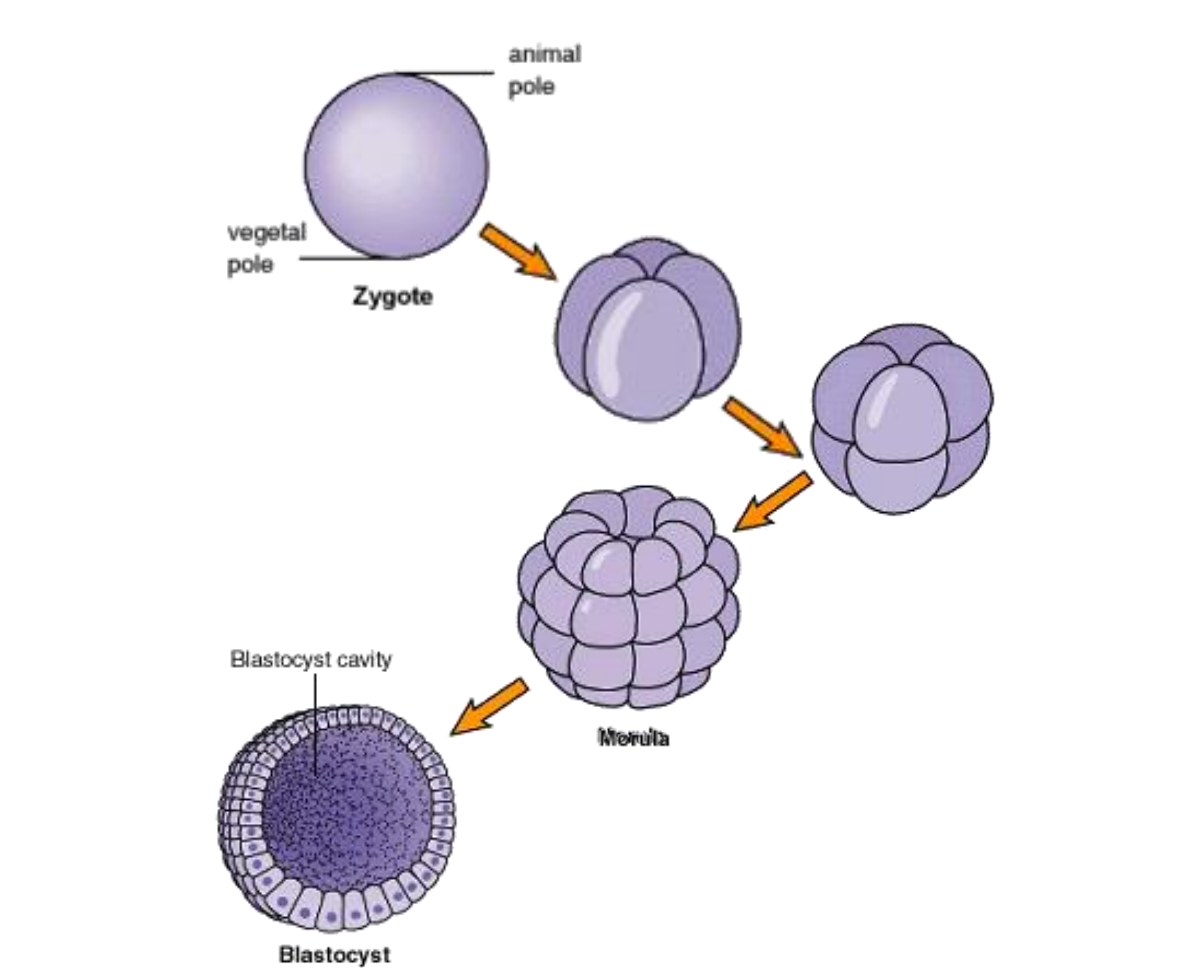
Zygote → Blastocyst
四、Pregnancy and lactation
Implantation, luteal rescue and early pregnancy

- Progesterone is required for the endometrium to remain in a highly developed state.
- Early during pregnancy, corpus luteal is the source of progesterone
- Later (50-70 d), Placenta is the main source for progesterone secretion (pregnancy lasts 266 days)
Placenta 胎盘
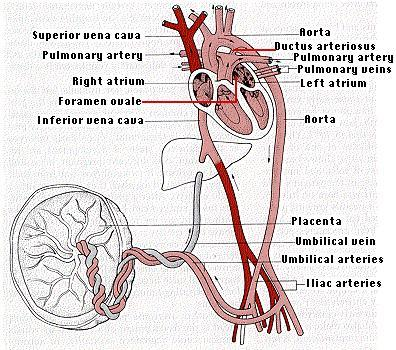
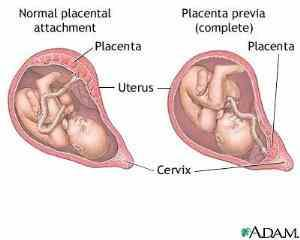
Humans and other primates employ chorionic gonadotropin to rescue the corpus luteum when pregnancy occurs
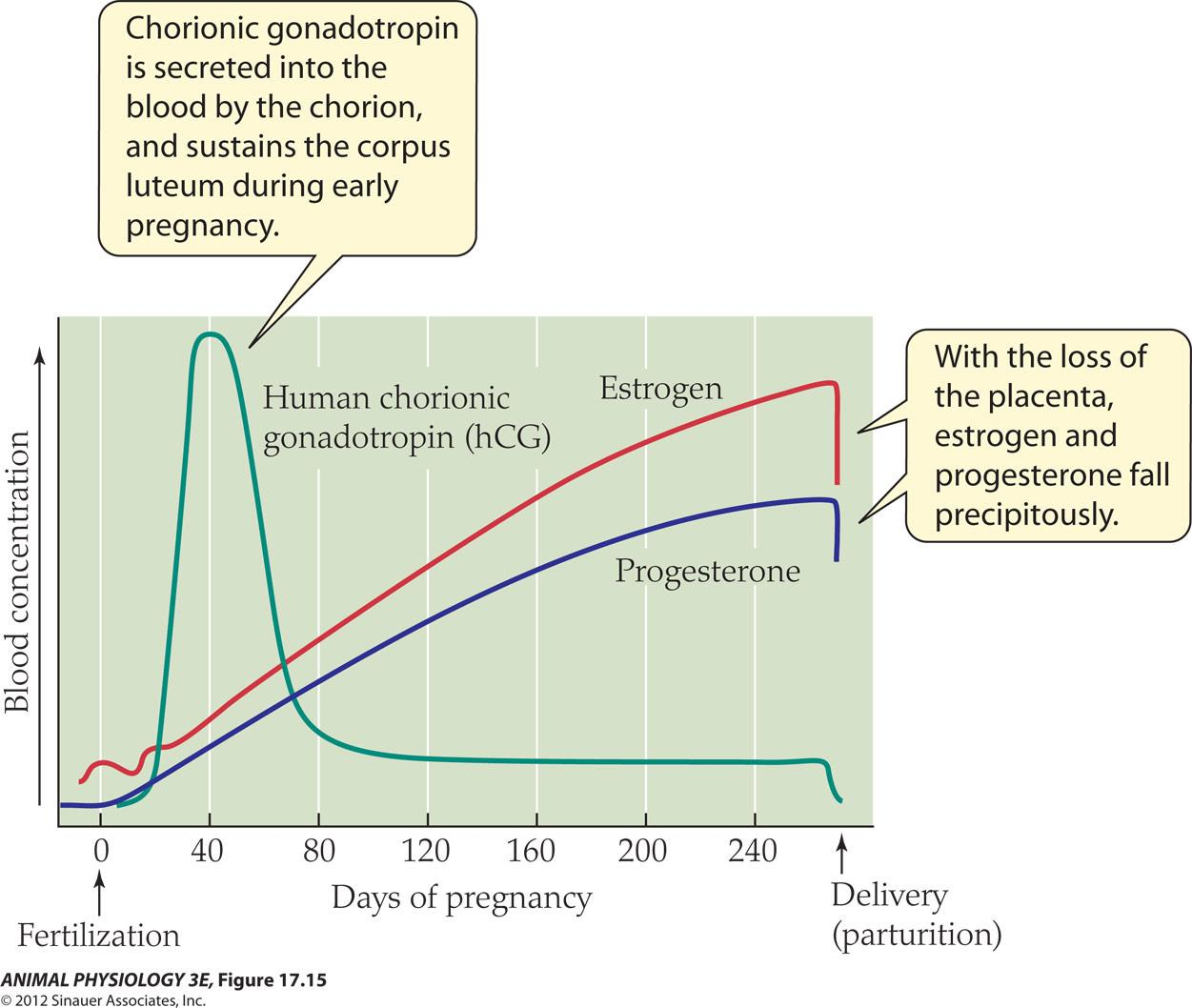
- Chorionic gonadotropin is secreted into the blood by the chorion, and sustains the corpus uteum during early pregnancy.
- With the loss of the placenta, estrogen and progesterone fall precipitously.
Positive feedback during birth
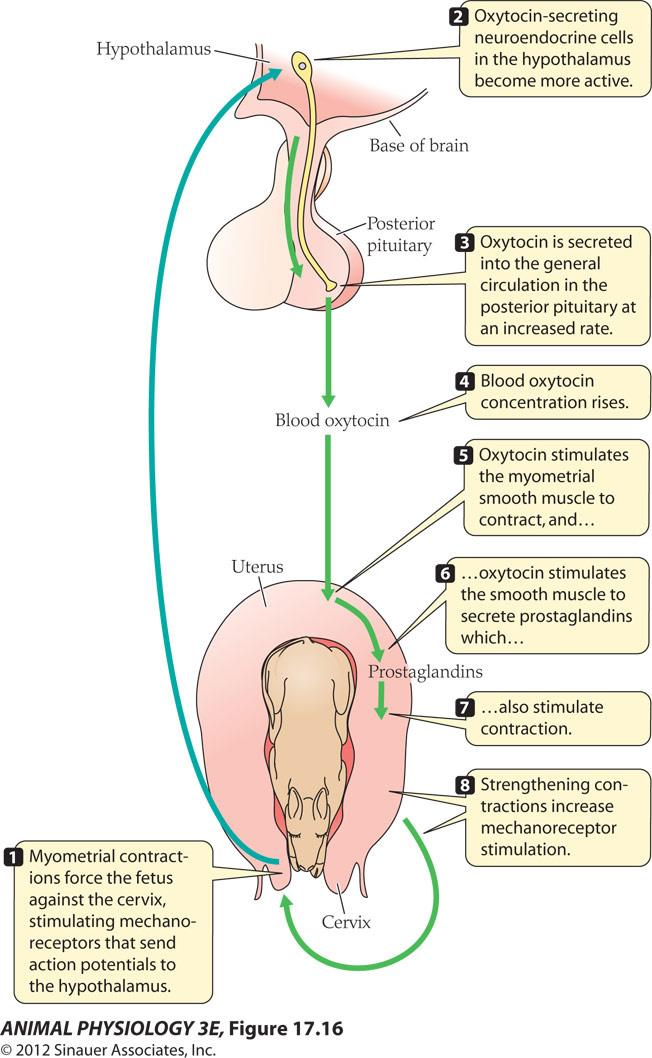
- Myometrial contractions force the fetus against the cervix, stimulating mechanoreceptors that send action potentials to the hypothalamus.
- Oxytocin-secreting neuroendocrine cells in the hypothalamus become more active
- Oxytocin is secreted into the general circulation in the posterior pituitary at an increased rate
- Blood oxytocin concentration rises
- Oxytocin stimulates the myometrial smooth muscle to contract
- Oxytocin stimulates the smooth muscle to secrete prostaglandins
- prostaglandins also stimulate contraction
- Strengthening contractions increase mechanoreceptor stimulation
Mammary glands and lactation 乳腺和哺乳
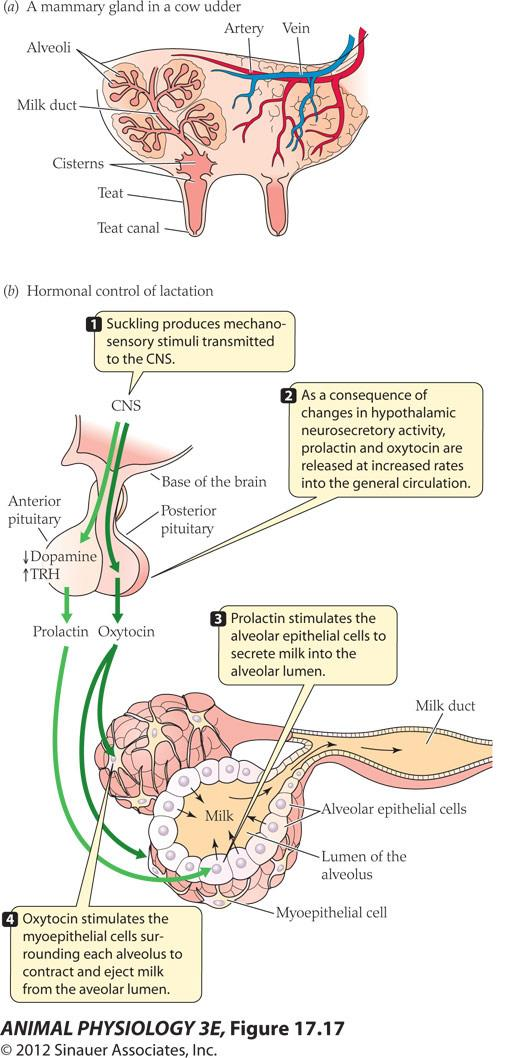
- Suckling produces mechano sensory stimuli transmitted to the CNS
- As a consequence of changes in hypothalamic neurosecretory activity. prolactin and oxytocin are released at increased rates into the general circulation
- Prolactin stimulates the alveolar epithelial cells to secrete milk into the alveolar lumen
- Oxytocin stimulates the myoepithelial cells sur rounding each alveolus to contract and eject milk from the aveolar lumen
Lactation is controlled by two hormones:
- Prolactin: secreted from the anterior pituitary gland to stimulate milk secretion
- Oxytocin: secreted from the posterior pituitary gland to stimulate milk ejection